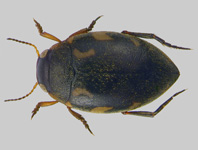Abstract
Stictonectes abellani sp. n. is described from the Iberian Peninsula. On average, the new species is larger and the colouration of the upper surface darker than in most other species of the genus. Seemingly the species has been confounded with others in the past, particularly S. optatus (Seidlitz, 1887). Males can be separated from externally similar species by studying the shape of the parameres. Additionally, the anterior margin of the clypeus is provided with a distinct rim in both sexes, which is absent or only weakly present in other species. The habitus and the male genitalia of the new species are illustrated, and compared with those of S. optatus. External morphological differences from other members of the genus are discussed. According to studies of the molecular phylogeny, based on fragments of four mitochondrial genes, S. abellani sp. n. is clearly separated from previously described species of Stictonectes Brinck, 1943, apparently being relatively basal within the genus. The new species is rather widely distributed in the south-western part of the Iberian Peninsula, inhabiting pools in small temporary siliceous streams. We provide distributional maps for all eight Iberian Stictonectes and estimate the potential distributional areas of the new species and the other two endemic Iberian species S. occidentalis Fresneda & Fery, 1990 and S. rebeccae Bilton, 2011, based on environmental niche modelling.

